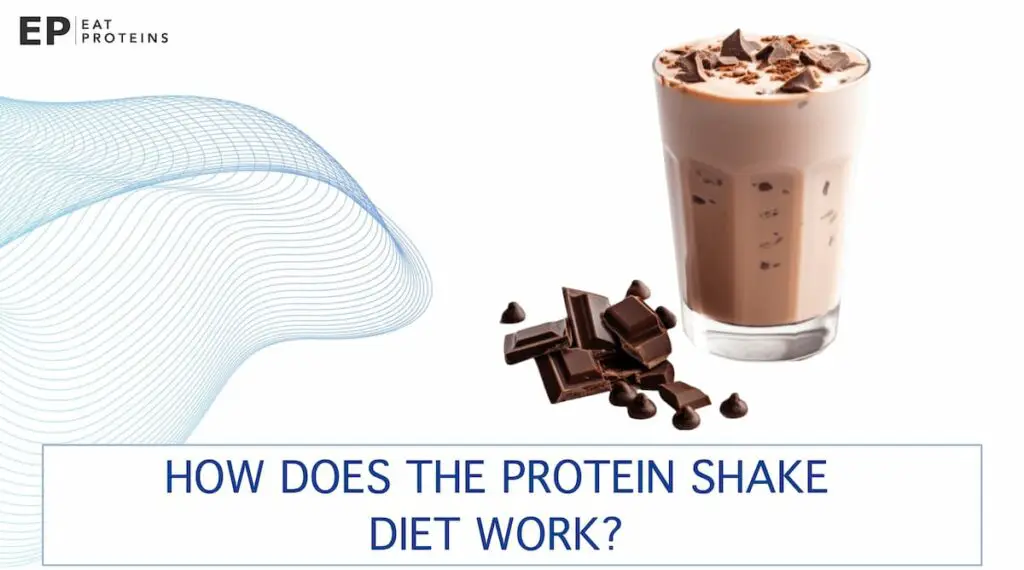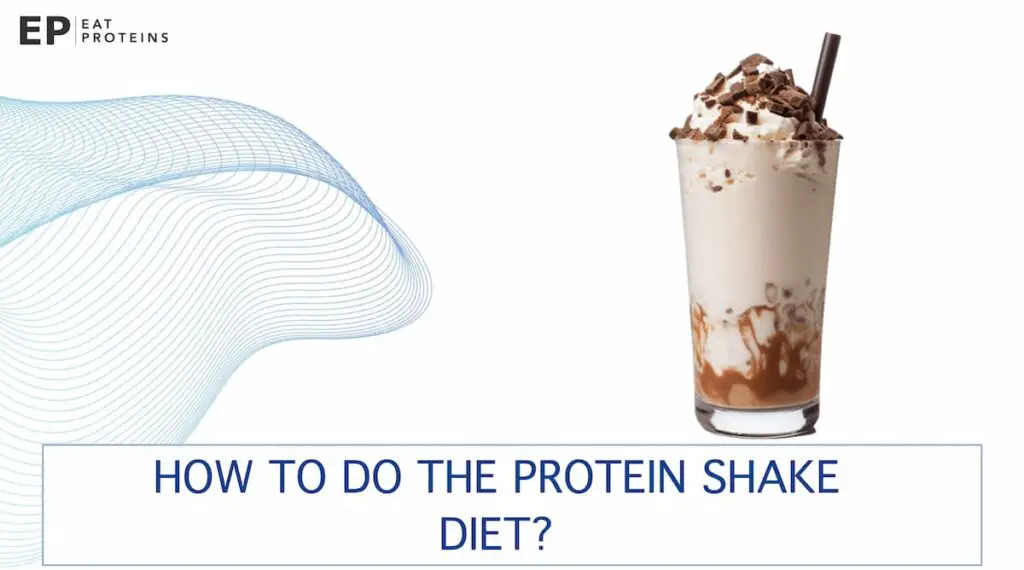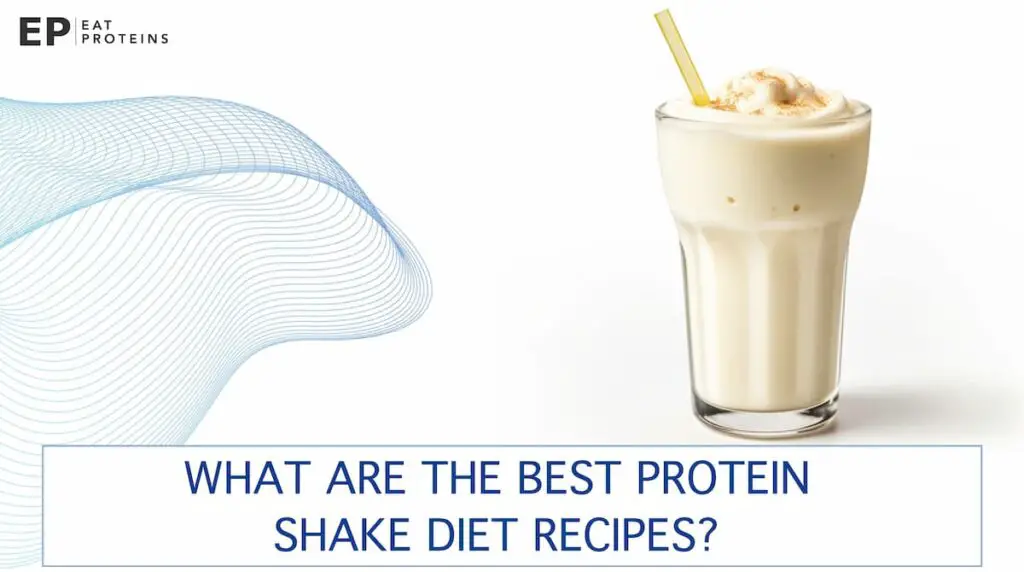The protein shake diet is a dietary regimen often utilized in bodybuilding and sports nutrition, focusing on the consumption of shakes rich in protein to improve athletic performance and physical appearance. The diet works by replacing some or all regular meals with protein shakes, thus providing essential amino acids for muscle repair and helping to create a caloric deficit for weight loss.
The primary benefit of the protein shake diet is its effectiveness in aiding weight loss and muscle gain, facilitated by a controlled caloric intake and high protein content. The main risk associated with the protein shake diet is nutrient imbalance, as relying solely on shakes can lead to deficiencies in essential vitamins and minerals.
What is a Protein Shake Diet?
The protein shake diet involves replacing one or more meals per day with protein shakes, aiming to reduce overall caloric intake for weight loss or muscle gain. According to a 2018 study by Jay Rabindra Kumar Samal from Manipal Institute of Technology, protein supplementation has become a common practice, not only among gym-goers but also among the general population.
On average, these shakes contain around 20 to 30 grams of protein per serving, and they are often used for meal replacement, weight reduction, and other purported health benefits. However, the study also notes that while protein shakes have various pros and cons, they should not replace whole foods completely, as they often lack other essential nutrients.
The primary function of the protein shake diet is to aid in weight loss or muscle gain by providing a convenient, high-protein alternative to traditional meals. The purpose behind its widespread use can be traced back to the increasing focus on protein supplementation for better health and fitness outcomes.
Originating as a tool mainly for athletes and bodybuilders, protein shakes have gained mainstream popularity in recent years. However, the 2018 study suggests that one should obtain the required protein intake from natural food sources whenever possible, resorting to supplementation only if the normal diet falls short of providing adequate protein.
How does the Protein Shake Diet work?
The protein shake diet works by replacing one or more meals with protein shakes, aiming to create a calorie deficit for weight loss. According to a 2021 study by Camila L. P. Oliveira from the University of Alberta, a high-protein shake diet can increase energy expenditure and fat oxidation during exercise.

The study also suggests that a high-protein intake can exert a stronger satiating effect, leading to decreased energy intake under ad libitum conditions. A protein shake diet may be particularly effective for males, who appear to experience greater exercise-induced weight loss than females.
What are the health benefits of the Protein Shake Diet?
The protein shake diet can have the following health benefits.
- Increased fat oxidation: Consuming a high-protein shake diet can lead to higher fat oxidation, which may facilitate weight loss and body fat reduction.
- Suppression of hunger: Protein shakes are known to have a greater satiating effect and can help reduce appetite, making it easier to adhere to a calorie-restricted diet.
- Improved metabolic profile: Protein shakes can improve metabolic markers such as insulin and cholesterol levels, contributing to better overall metabolic health.
- Enhanced muscle recovery and growth: Protein is essential for muscle repair and growth, and consuming protein shakes after exercise can aid in muscle recovery and promote muscle protein synthesis.
- Convenience and simplicity: Protein shakes offer a convenient and easy way to increase protein intake, especially for individuals with a busy lifestyle or those who struggle to consume enough protein through whole foods alone.
- Nutrient-rich supplementation: Protein shakes often provide other essential nutrients such as vitamins and minerals, which can help meet daily nutritional needs and support overall health.
- Versatile and customizable: Protein shakes come in a variety of flavors and can be customized with additional ingredients like fruits, vegetables, or healthy fats, allowing for variety and personal preferences in dietary choices.
What are the health risks of the Protein Shake Diet?
The protein shake diet, particularly with indiscriminate use of whey protein, can have adverse health effects, based on a 2021 study by Quezia Damaris Jones Severino Vasconcelos. The main organs affected are the kidneys and liver, with issues arising primarily from chronic and abusive use.
The study also linked excessive consumption of whey protein to aggravation of aggression, presence of acne, and modification of the microbiota. Therefore, it is crucial to consult with a healthcare professional before embarking on a protein shake diet, especially considering the potential risks when consumed in excess and without exercise.
What are the types of Protein Shake Diet?
The types of protein shake diets vary in their composition and can include combinations like protein shake and salad, protein shake only, or protein shake with water, among others. These diets typically aim for a protein intake ranging from 50g to 150g per day, depending on the specific plan.

- Protein Shake and Salad Diet: This diet consists of protein shakes and salads, aiming for 50-60g of protein and around 300-400 calories per meal.
- Protein Shake Only Diet: This diet comprises solely protein shakes, targeting a daily intake of 100-150g of protein and limiting caloric intake to 800-1000 calories.
- Protein Shake and Water Diet: This diet incorporates protein shakes and water, aiming for 50-60g of protein and around 300-400 calories per meal, while emphasizing hydration.
- Protein Shake and Fruit Diet: This diet includes protein shakes and fruits, aiming for 50-60g of protein and a caloric intake of around 400-500 calories per meal.
- Protein Shake and Soup Diet: This diet combines protein shakes with soups, targeting a protein intake of 50-60g and around 400-500 calories per meal.
- Protein Shake and Vegetable Diet: This diet includes protein shakes and vegetables, aiming for 50-60g of protein and around 300-400 calories per meal.
- Protein Shake and Egg Diet: This diet comprises protein shakes and eggs, aiming for a daily intake of 80-100g of protein and limiting caloric intake to 800-1000 calories.
- Protein Shake and Multivitamin Diet: This diet includes protein shakes and multivitamins, targeting a daily intake of 50-60g of protein and around 300-400 calories per meal.
- Protein Shake and One Meal Diet: This diet combines one solid meal with protein shakes, aiming for a protein intake of 50-60g and a total caloric intake of around 1000-1200 calories per day.
How to do the Protein Shake Diet?
To undertake the Protein Shake Diet, you’ll consume 2-3 protein shakes daily, contributing to a total of 50-150g of protein and an overall caloric count of 1,000-1,500 calories per day.

In addition to the shakes, you’ll have one balanced evening meal that includes lean protein, vegetables, and whole grains, aiming for 400-600 calories.
To maximize the diet’s effectiveness, it’s recommended to include regular exercise, as studies have shown that high-protein meal replacement shakes can enhance fat oxidation during workouts and suppress post-exercise hunger. This list shows 9 steps on how to follow the protein shake diet.
- Consume two to three protein shakes daily at scheduled times: breakfast, lunch, and bedtime, adhering to serving sizes based on your body type.
- Include one healthy whole-food evening meal, following calorie guidelines tailored to your gender and activity level.
- Add two other essential supplements to your regimen: one for omega-3 fatty acids and another for multivitamins.
- Drink at least eight 8-ounce glasses of water daily to help your body function optimally for fat loss and muscle gain.
- Incorporate one power walk per day and seek additional ways to be physically active throughout the day.
- Practice mindful eating techniques to enhance the taste of your food and help control cravings.
- Aim for at least nine hours of sleep per night to optimize hormone regulation and accelerate changes in body composition.
- Be prepared to adjust the plan based on your personal needs and results, such as modifying the caloric content of your solid meal.
- Utilize online coaching resources for expert advice, which can guide you through the diet and help troubleshoot any issues you encounter.
What foods can you eat on the Protein Shake Diet?
The protein shake diet allows you to consume protein shakes, lean meats, vegetables, fruits, healthy fats, whole grains, nuts, seeds, and vegetables.
- Chicken breast
- Salmon
- Spinach
- Berries
- Avocado
- Quinoa
- Almonds
- Chia seeds
What foods should you avoid on the Protein Shake Diet?
On the protein shake diet, you should avoid foods that are high in calories, sugar, and unhealthy fats.
- Processed snacks and desserts (chips, cookies, cakes)
- Sugary drinks and sodas
- Fried foods (French fries, fried chicken)
- High-fat dairy products (whole milk, full-fat cheese)
- Refined grains (white bread, white rice)
- Sweetened cereals
- Sugary condiments and sauces (ketchup, barbecue sauce)
- Fast food meals.
What are the best Protein Shake Diet recipes?
The best protein shake diet recipes focus on high-quality protein sources, low sugar, and added nutritional elements like fiber and healthy fats.

Incorporating ingredients like whey protein isolate, almond milk, and fruits like blueberries can enhance both the nutritional value and flavor of your shakes.
| Recipe Name | Ingredients | Steps |
|---|---|---|
| Berry Protein Blast | 1 cup almond milk 1 scoop whey protein isolate 1 cup mixed berries | Blend almond milk and whey protein in a blender. Add mixed berries and blend until smooth. |
| Chocolate Peanut Butter Shake | 1 cup cashew milk 1 scoop chocolate protein powder 2 tbsp peanut butter | Blend cashew milk and chocolate protein powder. Add peanut butter and blend until smooth. |
| Green Protein Smoothie | 1 cup coconut water 1 scoop vanilla protein powder 1 cup spinach 1 small banana | Blend coconut water and vanilla protein powder. Add spinach and banana, then blend until smooth. |
What is the grocery list for the Protein Shake Diet?
The grocery list for the protein shake diet should include high-quality protein powders, milk alternatives like almond or coconut milk, and nutritious add-ins like fruits, nuts, and vegetables. Additionally, supplements such as omega-3 fatty acids and essential vitamins, as well as a high-quality blender, should be on your shopping list.
- Protein Powders: Whey Protein Isolate, Plant-Based Protein
- Milk Alternatives: Almond Milk, Coconut Milk
- Fruits: Berries, Bananas, Apples
- Nuts and Seeds: Almonds, Chia Seeds, Flaxseeds
- Vegetables: Spinach, Kale
- Supplements: Omega-3 Fatty Acids, Multivitamins
- Spices and Flavorings: Cinnamon, Cocoa Powder, Vanilla Extract
- Blender: High-speed blender like NutriBullet or Vitamix
- Additional Items: Measuring cups, Protein shaker bottles, Ice trays
- Optional: Low-calorie sweeteners like Stevia and sugar-free syrups for flavoring.
What results can you expect from the Protein Shake Diet?
On a protein shake diet, you can expect to see moderate weight loss results, particularly if combined with a calorie deficit and regular physical activity; studies suggest a potential weight loss of 1-2 pounds per week. The high protein content also supports muscle preservation and may enhance post-workout recovery if you are engaged in strength training or aerobic exercises.
Based on the 2022 study by Sahar Alshamari from Hamad General Hospital, using protein shakes did not significantly affect excess weight loss but led to improvements in total protein, albumin, magnesium, and iron levels at 3 and 6 months.
What are the results of a 3-day Protein Shake Diet?
The 3-day protein shake diet involves consuming protein shakes exclusively for three days and then resuming normal food intake for the remaining four days of the week. According to limited studies and anecdotal evidence, individuals may experience a weight loss of approximately 2-4 pounds during the three days of protein shake consumption, although this can vary widely based on individual metabolism and activity level.
What are the results of a 7-day Protein Shake Diet?
A 7-day protein shake diet with a 500-calorie daily deficit may not provide significant weight loss, based on the 2008 study by Joy L Frestedt from the Minnesota Applied Research Center, but longer-term use can lead to an average body fat loss of 2.81 to 3.63 kg and preserve lean muscle mass by reducing loss to around 1.07 kg.
What are the results of a 14-day Protein Shake Diet?
Based on the 2021 study titled “Diet therapy program for weight loss and assessment of its effectiveness in overweight and obese persons,” the results of a 14-day protein shake diet led to an average weight loss of 6.3% of the initial body weight and a significant reduction in body fat mass by 9.2%.
The study involved 30 overweight or obese participants, who consumed a specific blend of amino acids, vitamins, and minerals three times a day for 14 days, along with a 400-kcal evening meal. The regimen resulted in statistically significant improvements in body composition and metabolic parameters, including reductions in serum glucose, total cholesterol, and triglycerides.
What are the results of a 30-day Protein Shake Diet?
The results of a 30-day protein shake diet, as supported by a 2022 study by Erin L Glynn from Beachbody, LLC, can lead to a weight loss of approximately 1.1 kg and a decrease in body fat percentage by roughly 0.44%.
The study involved 206 healthy overweight and obese adults who were randomly assigned to consume either a high-protein and fiber-based multi-ingredient nutritional shake or a low-protein, lower-fiber placebo shake. The study found that the high-protein group experienced greater weight loss (-3.3 kg) compared to the low-protein group (-1.8 kg) and also observed improvements in metabolic markers like cholesterol levels.
What should you know about the Protein Shake Diet?
What you should know about the protein shake diet is that it has evolved significantly since its inception in the 1950s, now offering a variety of protein sources like whey, casein, and plant-based options.

One example, the Velocity Diet, is a 28-day program designed to accelerate fat loss and muscle gain by incorporating four daily protein shakes, one whole-food meal, and essential supplements.
This diet also includes lifestyle components such as cold-water consumption, daily exercise, mindful eating techniques, and an emphasis on getting enough sleep. While protein shakes can be a convenient source of nutrients, they should be part of a balanced diet and lifestyle, rather than a complete replacement for whole foods.
How long should you do a Protein Shake Only Diet?
The duration for a protein shake-only diet can vary based on numerous factors such as initial body weight, target weight loss, age, gender, metabolic rate, and activity level.
If you’re aiming for a moderate weight loss of 5-10 pounds, a time frame of 2-4 weeks could be considered, assuming a daily caloric deficit of about 500 kcal leading to approximately 1-2 pounds of weight loss per week. However, it’s generally not recommended to be on a protein shake-only diet for an extended period due to potential nutrient deficiencies and other health risks.
Can you follow a 7-day Protein Shake Diet safely?
Yes, you can follow a 7-day protein shake diet safely, but several factors must be considered for individual safety. For older adults, a daily protein intake should not exceed 1.2-1.5 grams per kilogram of body weight, while people with kidney disorders should limit protein to less than 1 gram per kilogram.
Men and women may require different caloric intakes, with men often needing more calories, and anyone with pre-existing medical conditions like diabetes should consult a healthcare provider due to potential medication interactions.
Is a Protein Shake Diet considered a healthy plan?
Yes, a protein shake diet can be considered a moderately healthy plan if executed carefully, but it is not universally suitable for everyone. When it comes to nutrient density, a high-quality protein shake can provide around 20-30g of protein per serving along with essential nutrients, aiding in effective fat loss and muscle preservation.
Is the Protein Shake Diet a form of meal replacement?
Yes, the protein shake diet can be considered a form of meal replacement if it meets certain criteria. For nutritional completeness, a protein shake should contain all essential nutrients, including a balanced vitamin and mineral profile.
Can you exclusively rely on a Protein Shake Diet?
No, exclusively relying on a protein shake diet is generally not recommended due to several factors. Nutritionally, protein shakes can be limited in terms of macronutrient distribution, often lacking in essential fats and carbs. Health outcomes such as weight loss may occur, but the diet can have negative impacts on metabolic rate, and blood sugar levels, and may increase LDL cholesterol while decreasing HDL levels.
How to incorporate Protein Shakes into a healthy balanced diet?
The following list shows how to incorporate protein shakes into a healthy balanced diet.
- Aim for a macronutrient ratio of around 40% carbs, 30% fats, and 30% protein, keeping daily caloric intake within your target range (e.g., 2,000-2,500 calories for an average adult).
- Consume shakes before and after workouts for muscle repair and energy, and consider using them as meal replacements, making sure they contribute to a balanced intake of vitamins and minerals.
- Take into account any dietary restrictions or goals, such as lactose-free or vegan options, and choose shakes that have low sugar content and high fiber for better glycemic control.
- Opt for reputable brands that offer cost-effective, natural, and organic ingredients, ensuring the product aligns with your physical goals, whether it’s weight loss or muscle gain.

